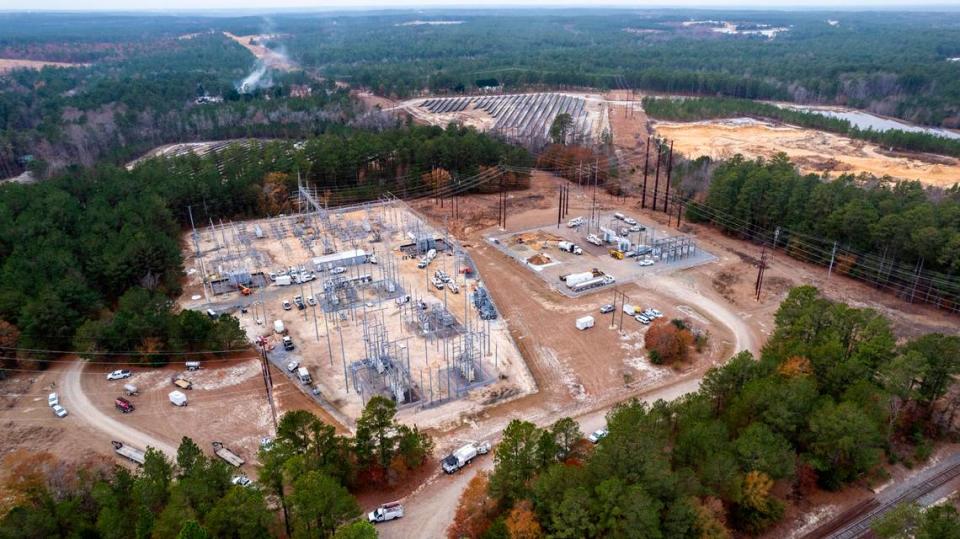4 takeaways on the Moore County substation attack for Charlotte, big banks and security
The weekend attack on two electrical substations in Moore County — about two hours east of Charlotte — caused thousands of residents to lose power and raised questions about our power grid’s vulnerability.
The implications of the Moore County attack can be especially important for a city like Charlotte, home to big corporations like Duke Energy and financial institutions like Wells Fargo Bank of America and Truist.
It’s still too early to say what response might be necessary to make the overall grid more resilient after the Moore County attack, said Michael Mazzola, executive director of UNC Charlotte’s Energy Production and Infrastructure Center.
He noted that big banks typically have back up sources of power, similar to hospitals.
The center’s students and faculty research ways to make sure electricity is reliable and affordable. That reliability can be regularly threatened by weather events like ice storms and hurricanes, forcing people to lose power, said Mazzola, who is also a professor of electrical and computer engineering.
Then, there’s what happened to the power grid in Moore County, where an attack on two Duke Energy substations using firearms left thousands of residents without power. Authorities are still searching for suspects and motives.
These attacks are not unheard of but they’re also not common. You’re more likely to hear about instances of people vandalizing substations, like stealing copper, said Mazzola.
As the investigation into what happened in Moore County continues, here are four of Mazzola’s takeaways on this latest threat to our power grid.

Flashbacks to 2013 California grid attack
When Mazzola first read about what happened in Moore County, he was immediately reminded about the Metcalf sniper attack. In 2013, at least two people armed with rifles opened fire on Pacific Gas & Electric’s Metcalf substation outside San Jose, California.
The attack — which remains unsolved — caused about $15 million in damage. But it had little impact on the grid and not many people lost power. The motive in the attack remains unclear.
That’s what surprised Mazzola about Moore County. If we assume whoever carried out the attack wanted residents to lose power, then — unlike California — that attack was a success.
But Mazzola says it’s difficult to draw conclusions from these two events alone. “I’m sure that there will be additional lessons learned from this,” he said.
So what could act as a deterrent from making sure this doesn’t happen again? Justice, Mazzola said, or demonstrating there are consequences for such attacks.
How vulnerable is North Carolina’s power grid? It’s not a new issue.
What about Charlotte’s big banks?
Charlotte is a banking town. Big financial institutions like Wells Fargo, Bank of America and Truist all have a major presence here. We thought it’d be worth asking what sort of backups these companies have in place if an attack like Moore County were to happen here.
Back-room operations and data centers are likely to have their own backup power if a loss of electricity occurred, Mazzola said. Banks have an incredible incentive to not lose power because of the money they’d lose, he said.
While not required, most banks have back-up generators at corporate locations and most branches, Sally-Ann Gupta, spokeswoman for the North Carolina Office of the Commissioner of Banks, told The Charlotte Observer in an email.
Most banks, Gupta said, also have secondary locations that are far enough away from the corporate offices to be on a secondary grid.
Disaster recovery plans and a bank’s business continuity plans are reviewed regularly, both by management and external auditors.
Wells Fargo declined to make anyone available for an interview with The Charlotte Observer. Bank of America and Truist did not return a request for comment.
For Charlotte-based Duke Energy, the company regularly monitors the protection of its critical infrastructure and deploys additional security when appropriate, Logan Kureczka, a Duke Energy spokesperson, told the Observer in an email.
Duke Energy facilities are designed with back-up systems and the company plans to spend $75 billion in the next 10 years on grid improvements.
Smarter electric grids needed
Investigators will be working hard in the coming days and weeks to figure out who carried out the Moore County attack and why. But there also are longer-term questions at hand.
For Mazzola, that includes thinking about developing what he calls a smart grid. That would include figuring out ways to get power back faster to a damaged substation. One way is to redirect energy from another nearby substation.
Another way is by creating “micro grids” by using other sources of energy like solar, Mazzola said.
More points of connection and varying ways of getting energy to the user means it would be harder for an attacker to do anything that would cause widespread disturbances, he said.
Cautions on how to react to Moore County attack
In the days since the attack, questions have come up about our grid’s vulnerability.
The event has highlighted the lack of certain equipment needed to repair or replace components like transformers, the news outlet The Hill reported. It’s also another example of an increase in “major disturbances and unusual occurrences” on the electric grid per a Department of Energy report, according to The Hill.
Gov. Roy Cooper said this week the Moore County attack was “too easy,” and that we need to assess where we are on our critical infrastructure.
Mazzola agrees that equipment like transformers are fairly unique and are not easily or quickly replaced.
But he also cautioned against over-reacting and predicting what the correct response should be in Moore County. Physical security needs to be taken seriously but it’s not clear if this is an accelerating threat.
